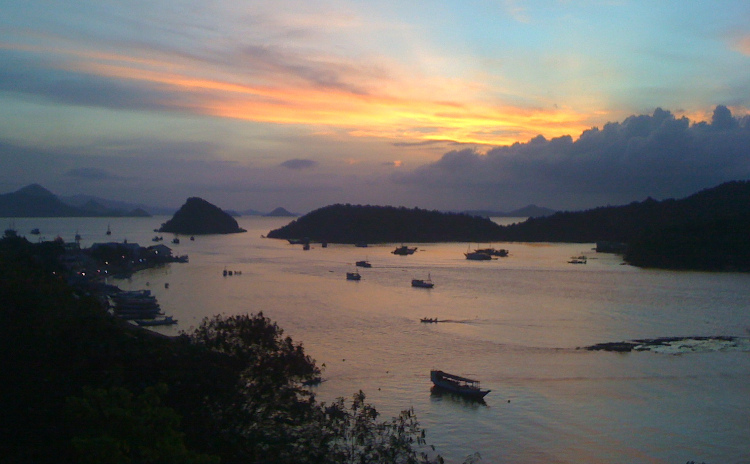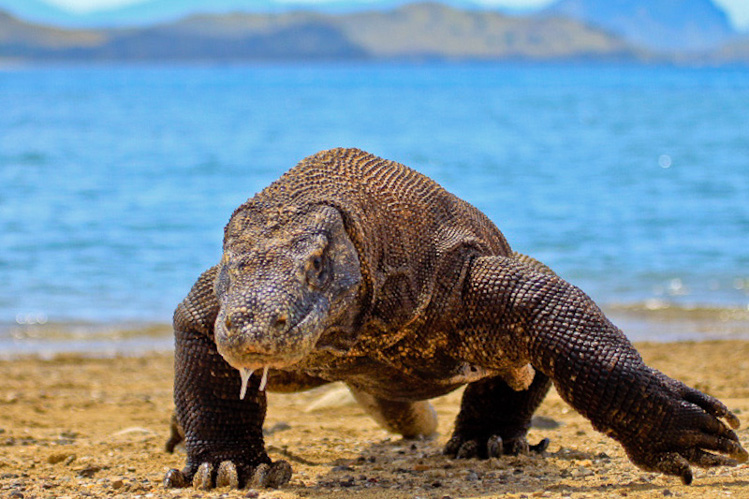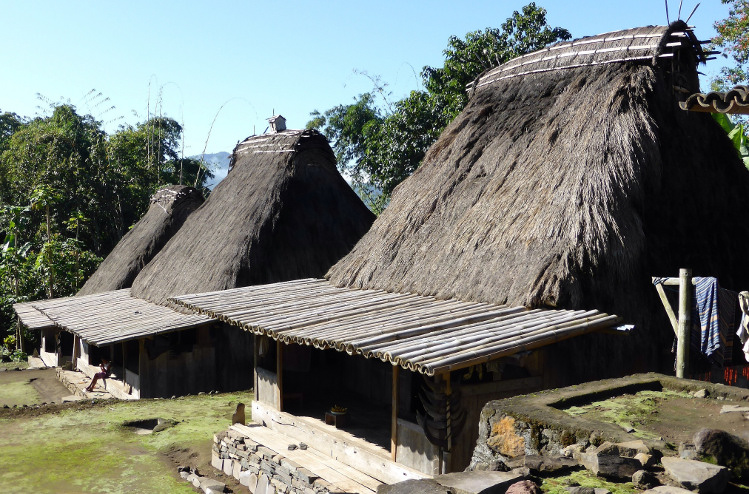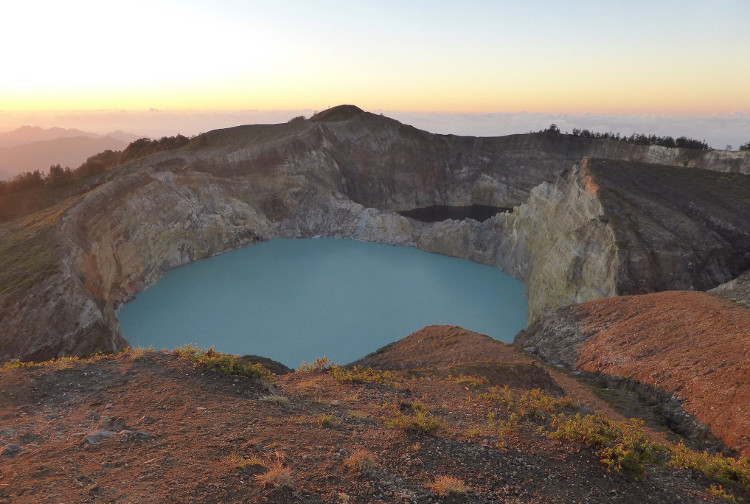It makes sense. After all, Flores is the kind of gorgeous that grabs hold of you tightly. It has empty white sand beaches and bay islands, excellent diving and snorkelling and a skyline of perfectly shaped volcanoes. The 700km trans-Flores highway that connects the east and west coasts skirts knife-edge ridges that sheer into spectacular river canyons, brushes by traditional villages and leads to multi-hued volcanic lakes. For years this tropical jewel box remained a secret, its gems accessible only to those willing to venture off the beaten track. But thanks to steadily improving infrastructure and a maturing tourism industry, Flores is blooming like never before. Most visitors hire a car with a driver and take it all in on a long slow road trip, making sure to linger, before or after among the national park’s Komodo dragons.
 Sunset, Labuanbajo, Flores. Image by David Harris / Flickr CC BY 2.0
Sunset, Labuanbajo, Flores. Image by David Harris / Flickr CC BY 2.0
Tucked into the country’s west coast, Labuanbajo is a little, romantically ramshackle bay harbour town that is not so little anymore. In the past three years, the harbour has doubled in size and the population has exploded. These days, visitors from all over the world check into sweet and homey guesthouses etched into the rugged hills – or one of the new tower hotels down the coast – to take in the surrealist sunsets and book passage to the national park. Meanwhile, hundreds of young Flores locals are drawn to Labuanbajo for work, which lends a lively boomtown bustle. While the town’s chief attractions remain offshore, thanks to excellent restaurants like Made In Italy (www.miirestaurants.com) and Mediterraneo (www.mediterraneoinn.com) there is a growing dining and nightlife scene brewing in this charming town that makes it hard to leave.

Of course, Labuanbajo initially popped on traveller’s radars because of Flores’ 1817sqkm Komodo National Park, which includes more sea than land, nurtures reef systems that lure an array of underwater life and protects the largest lizard on earth. Komodo dragons are gargantuan swaggering beasts that live on two rugged islands in the national park – Komodo and Rinca. In 2014, the rare beasts were also found to be living in Mbeliling Forest on Flores. These prehistoric giants grow to more than three meters long and weigh up to 100kg. You can charter a local boat from Labuanbajo for two or three day cruises in park waters, snorkel over pristine reefs, lounge on pink sand beaches and hike on Rinca and Komodo (one and a half and three hours by boat from Labuanbajo respectively).
Rinca, 17 nautical miles from Labuanbajo, gets the most visitors, as the dragons tend to congregate around the park ranger offices and spotting them is easy. But more fulfilling is a day hike on the spectacular and remote Komodo island, 22 nautical miles from the mainland. Consider a guided trek through Poreng Valley on the island’s northeastern flank, where you will likely spot a dragon in the scaly flesh, and up and over Bukit Randolph, a 1835ft-high peak that looms between two harbours, Loh Sebita on the more exposed northeast coast and Loh Sebita, a sheltered bay further south and west, where your boat can pick you up.
Of course, you will be forgiven if you wish to spend most of your waking hours underwater. After all, if the snorkelling around Flores can be sublime - and it can - then the diving is best described as a raw, life-affirming adventure. Currents are strong, which keeps the water nutritious, the reef alive and lures big pelagic fish. With luck and good timing you are likely to see schooling reef sharks and manta rays, the occasional dolphin pod, and thousands of colourful fish swirling and flaring like fireworks. Wicked Diving offers wonderful three-day or six-day live aboard packages, Divine Diving runs excellent day trips to the national park from Labuanbajo, and Komodo Resort Diving Club on Pulau Sebayur allows you to dine and sleep amid barefoot luxury on a private island (just outside the park boundaries) an hour by boat from Labuanbajo and fifteen minutes from the national park, and thoroughly explore the park above and below the surface.

Next, leave the coast behind and head inland to explore traditional villages that have barely changed over the last few centuries. There are still buffalo sacrifices on wedding days and funerals, and you will see horns displayed outside thatched, traditional wooden bungalows as a show of status and wealth.
The market towns of Ruteng, in the mountains of western Flores, and Bajawa, a mountain town close to the island’s centre, are the main gateways to these indigenous communities. If you are willing to take the time and hike through the jungled steeps, you can overnight in the thatched conical homes of the isolated Wae Rebo people. The splendid hike and unique architecture is enough of a reward, but you will also be treated to traditional music and dance, as well as a demonstration of ikat, local weaving and dying practices to make tapestries.
There are more vehicle-accessible villages around Bajawa; Bena, on the flank of the 2245m high Gunung Inerie volcano is one of the most interesting, with stunning megaliths and a community of thatched roof houses lined up in two rows along a ridge. In between are totem-like ngadhu (dedicated to male ancestors) and house-like bhaga structures (dedicated to female ancestors) smeared with sacrificial blood. The best way to explore these remote villages is to book with Manumadi Tour and Travel (www.manumadi.com).

No Flores trip is complete without a steaming cup of ginger coffee and a glorious sunrise over Kelimutu crater, where you will find the tri-colour lakes just east of the island’s centre point, looming above the village of Moni. Check into the plush Kelimutu Ecolodge (www.ecolodgesindonesia.com) - but expect an early wake-up call. Ever since locals led Dutch settlers here in the early 17th century, sightseers have made the sunrise trek to the chameleonic volcanic lakes that are so densely colourful they seem as thick as paint. It's thought that dissolving minerals, a process that can accelerate in the rainy season, accounts for the shifting colour scheme. One of the lakes never changes from turquoise, but the other two blush yellow, orange, red and brown, depending upon the time of year. The summit’s moonscape gives Kelimutu an ethereal atmosphere, especially when clouds billow across the craters and sun shafts burn luminescent pinpoints on the water’s surface. Kelimutu is sacred to local people, and legend has it that the souls of the dead ascend to these lakes, suggesting that they may be a portal to eternity.